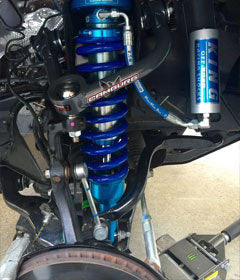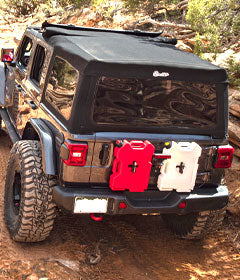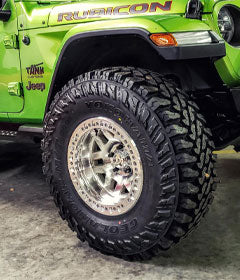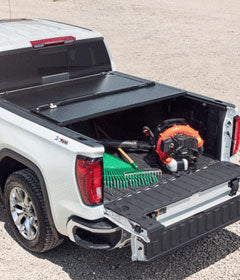The winch provides the best way to get unstuck, whether it’s your rig or someone else’s. Winches generate considerable pulling power. Most 4×4 rigs use winches in the 8000 pound to 12000 pound pulling capacity range. If you have ever witnessed a winch pulling near its load capacity, you have a clear idea of the power a winch creates. With the power comes genuine risk. From the winch to the winch line and the shackles used to couple everything, every part of the winching system must provide adequate strength to handle the massive loads. Catastrophic failures happen. Significant damage can occur, and serious, even fatal injuries are possible. Winches and winching gear need to be handled with care, respect, and common sense.
WINCHING SAFETY TIPS
- Always wear gloves. When working with wire rope, the steel strands can fray and cause nasty cuts.
- Always conduct winching operations with the engine running on the winching vehicle. Winches draw a lot of amperage and can drain a battery very quickly.
- Before beginning the rigging for a winching operation, take a few minutes to analyze the situation. Rushing into the recovery can lead to mistakes that can make the process more difficult, time-consuming, and dangerous.
- Winches need a solid, stable base to pull from. Large trees, large rocks, or other vehicles make good anchor points. A ground anchor like the PullPal or Deadman work in soft surfaces when there is nothing else to pull against.
- If you use a strap around a rock, make sure it is large enough and firmly planted in the ground to handle the winching load. Dislodging large rocks is more common than you would expect.
- Pull out the winch line from the spool by hand with the clutch lock released to ensure the line isn’t doubled over when rewinding. When doubled over, the line suddenly reverses direction and gives the person pulling out the line a tug.
- After a winching operation, always re-spool the winch line to assure that the winch line has not doubled back on itself.
- As the last five feet of the winch line is rewound, hold the winch line by the hook or link, not the winch line. Holding the winch line can allow your hand to be pulled into the fairlead resulting in an injury. Tap the winch remote control quickly to spool in the last few inches so that the winch line is not under a heavy load when not in use.
- Keep everyone away from the swing zone of the winch rope. This is the radius that the winch line could swing if the connection were to break at either end. This zone has two radii, one at each end. The best place to be is to the side of either the rig being pulled or the anchor point. Anyone within the winch line swing zone is at significant risk if the winch line or any attached component fails. Synthetic winch rope is much safer than steel winch rope, which, when under tension, can act as a slingshot.
- When tightening a shackle, turn the threaded pin until it is snug, then back it off a quarter turn. This will make it easier to unscrew the pin when the operation concludes.
- Never use a winch end link on a non-winching vehicle as an anchor point for winching.
- After putting a little tension on the winch line, place a line dampener on the winch line. This is especially important when using steel winch rope, as it is not self-dampening like synthetic winch rope. A winch line dampener is any fabric weighing at least 4-5 pounds that can be draped over the winch line. Should the line snap, the dampener will minimize the snapping effect of the broken line and reduce the flinging of the line itself or items attached to it. A dampener could be a large towel, jacket, blanket, sleeping bag, or a special winch line dampener designed for this purpose. While synthetic winch line is much less dangerous, a dampener should still be used.
- Unless the vehicle being winched is disabled, the driver should be assisting the winch by driving slowly.
- Only one person should be in charge of the winching operation.
- Assign tasks to others as needed. Ensure someone is positioned to watch the vehicle being winched to make sure there are no binds or other potential problems. Someone else should watch the anchor point. Make sure everyone is on the same page for communication, both verbally and with hand signals. Keep it simple, like a thumbs’ up and verbal Okay for pulling and a Stop with a balled fist thrust into the air to stop winching. Make sure the observers are out of harm’s way before the winching operation begins.
- Always have at least five wraps of winch line around the drum before winching. This is the minimum to assure no slippage of the line on the drum.
- A winch design follows the laws of physics. As layers of winch line accumulate on the winch drum, pulling power decreases. Winch power can be reduced nearly 50% from maximum when the line is five layers thick vs. the single layer. If you have a difficult pull, play out the winch line as much as possible to maximize the pulling power; if necessary, use a snatch block to play out more line. The pulley will also increase the pulling power by twice while reducing line speed to half.
- Always use a tree saver strap when pulling from a tree. Make sure the tree is strong enough for the winching load. Placing the tree saver close to the base of the tree reduces leverage on the tree, and the base is the strongest area of the tree trunk. Use a wide tree saver strap. Three-inch straps are good. Four or five-inch wide straps are better.
Winches are a powerful, useful tool. When used properly, they offer a great way to get unstuck, hopefully for someone else. Misused, winches can prove to be deadly. Use your winch wisely, respect the power, and you will have a tool that will serve you well for a very long time.












